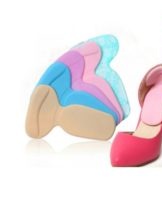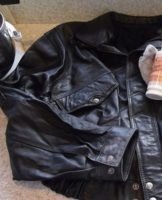How to choose and sew a tulle curtain strip at home
It is not a problem to beautifully decorate a window if you know how to sew curtain tape on tulle correctly. The wide range of such sewing accessories puzzles many, they need the help of a consultant when buying. To create the desired assembly using the tape, you need to select the tape of the appropriate width, length and texture.
Description and purpose
Tapes for curtains are wide and narrow (1.5-10 cm), transparent and opaque (white), differ in the base material, the number of cords and the method of attachment. 70 types of these sewing accessories are produced. Each type of ribbon has characteristics that are taken into account when choosing:
- width;
- fabric type and density;
- number of strings;
- the presence of seals;
- how many rows of pockets for fastening;
- building factor.
It is important for skilled seamstresses to know what types of pleats can be made with curtain tape. It's hard to imagine sewing curtains without using braids. With its help, several tasks are solved:
- handle the top edge of the product with care;
- provide the canvas (tulle, curtain) with loops, they are necessary for fastening to the cornice;
- lay pleats, creating draperies.
How to choose
First they buy tulle, curtain fabric, then braid. When choosing, the length of future curtains and the density of the material are taken into account. A narrow ribbon with 2 rows of loops is sewn on short light curtains made of silk, organza, veils and chintz. For the design of massive curtains, a wide curtain strip is used.
Types of folds
Pleats are formed using cords, they are stretched from the back of the braid. The more intricate the drapery, the wider the curtain strip.
Waffle
This is what the opposite folds are called. They are made on dense fabric curtains. A ribbon with a width of 7-7.5 cm with a gathering factor of 1-2.
Pencil
The shape looks like a pencil. Not wide, loop-shaped folds of the same width are located at an equal distance from each other. A tape with a gathering factor of 2.5-3 is suitable. The curtain is first attached to the cornice, then they begin to stretch the cords and lay the folds, taking into account the hooks, the width of the window opening and the canvas.
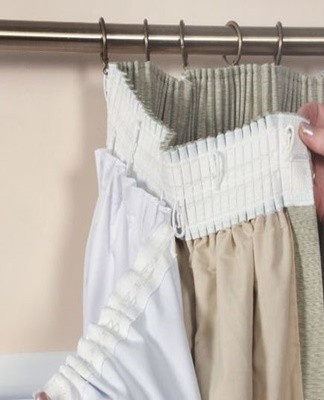
Bow
Look good on wide tulle and ruffles. On sliding curtains, bow folds are not impressive. Curtain tape with a pucker factor of 2.5 cm and more, a width of at least 5 cm is suitable.
Flemish
V-shape. A wide braid with a gathering factor of 2 and 2 rows of cords is suitable for their creation. The design of tulle (curtains) in the Flemish style will have to work hard. This type of drapery is complex and requires the expertise of the seamstress.
Ribbon type
A suitable braid is selected according to several criteria.The first is the type of cornice (open, closed), the width of the tape depends on this. The second is the type of attachment (hooks, Velcro, rings). The third is the type of fabric (thick, thin).
Transparent
The base of the braid is nylon. Transparent ribbons are used to decorate the upper edge of curtains made of transparent and light fabrics:
- report;
- organza;
- sail.
Clear tape requires some skill. It is necessary to select the right thread and the right sewing needle so that the seam does not pull, it is even and neat.
Opaque
The braid is made of cotton, so it shrinks in the wash. This is taken into account when buying, taking into account the unknown shrinkage. Before sewing, the curtain tape is soaked in hot water and steamed with an iron.
By the method of fixing to the curtain
The gutters are different, the manufacturers take this into account. There are curtain tapes on sale that are suitable for different types of fastening.
Hang
Ceiling cornices are equipped with special plastic hooks. A braid is sewn to the curtains, which has 1-2 rows of pockets (loops) for hanging them. Ribbons with multiple rows of loops are convenient because they can be used to easily adjust the length of curtains.
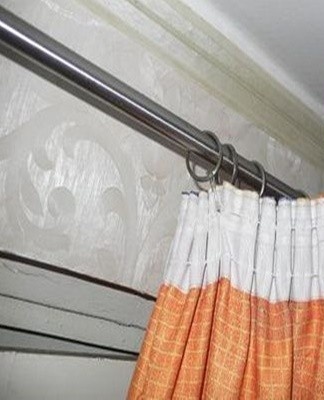
Combo mount
There are 2 options for attaching the curtains to the ribbon: Velcro, loops.
Sticky
When sewing Roman, Japanese blinds use Velcro (velkro). It consists of two ribbons. In one, the surface is soft, fleecy, in the second it is covered with small hooks. When they come into contact, a strong connection is formed. Part of the tape is attached to the window frame (cornice) with a stapler, glue and self-tapping screws. The second part is sewn to the upper edge of the curtains.
On string ledges
The string cornice is a metal cable. The curtain is attached to it with hooks, loops, eyelets.
On the carnations
The narrow orientation eyelet tape is rigid, it is made of nylon. It has an adhesive backing. It is processed along with the edges of the curtains if they plan to insert eyelets - metal or plastic rings. This type of tape is glued to the fabric using a hot iron. Hot melt adhesive forms a strong bond. Curtain tapes for eyelets are available in different widths - from 5 to 15 cm. When choosing, they are guided by the diameter of the rings.
Types of eyelet tape:
- single-layer - adhesive base applied on one side;
- two layers - an adhesive base is applied on both sides.
On pipes of different sizes
There are varieties of eyelet tapes with pockets. They are glued to stiffen the edge of the fabric. Curtains with such strips do not need rings. They are attached to the cornices in a different way. The hose is threaded into evenly distributed pockets along the entire length of the braid.
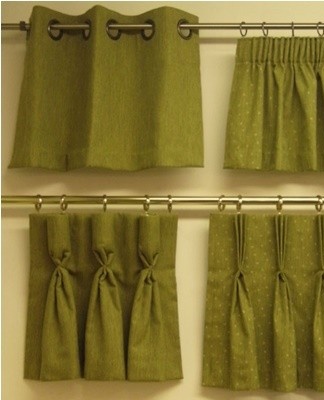
By width
The more they want to drape the curtains, the wider they take the braid. When choosing, consider the material of the curtains. Tulle, veil, organza are worked with a braid of fishing line. It is transparent, it is not visible through thin curtains. When sewing thick curtains, you need cotton, polyester or paper tape. It's rough, but does a good job of draping heavy curtains.
Narrow
Braid width 25 mm. It is used for sewing curtains of lightweight fabrics of simple design. Fastening to the cornice (closed, ceiling) is the main purpose of a narrow tape. It is suitable for lambrequins, simple tulles and curtains for the country.
Wide
The width of the braid is 60-100 mm. Wide ribbons are used for sewing thick curtains, lambrequins with a wide bar. In curtains hanging from decorative cornices, folds are not visible, for them this type of braid is relevant, they are used in cases where:
- bracket for fixing open type curtains;
- there are few hooks on the bracket;
- for the complex decoration of fabrics.
Useful tips
Tips on choosing a curtain strip. To process a thin airy veil, a polyester curtain tape is suitable. It firmly holds the canvas across its entire width. Tulle looks great if the hooks are hung in 8-10 cm increments.
Tips for aligning the edge (top, bottom) of curtains. You need to take a step back from the edge of the canvas, pull 3 threads. A clearly visible path is formed along which it is easy to make an even cut. Sewing tape on a straight edge is much easier.
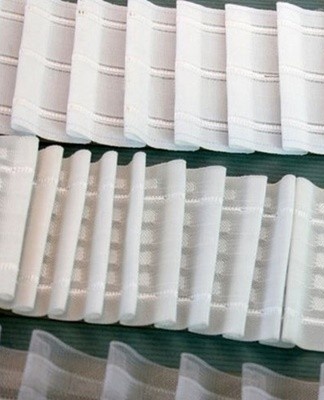
Tips for cutting the side hem properly:
- fold the upper edge to the width of the braid;
- put the tape on the hem (pockets up), stepping back from the side edge by 3 cm;
- nail;
- flash on a typewriter;
- process the edges of the curtains with a double hem, its edge should overlap the side edge of the curtain fittings, do not sew the cords, they should be on top.
How to determine the quantity
Measure the length of the eave, not the size of the window opening. The resulting value is used to calculate the length of the curtain strip. It is recommended to buy it 10-15 cm longer. Allocation is necessary for several reasons:
- for hemming while sewing;
- the cotton braid shrinks a few centimeters after heat treatment.
If you want to get a slight wave, get a braid with a gather factor of 2. For non-professional seamstresses, this is the most popular type of curtain tape. When using ribbon with a gather factor of 2, 2m of organza is needed to fill 1m of pleat curtain. When calculating the length of the fabric, use the formula:
- Amount of material = KC * L + tolerance;
- KC is the assembly factor;
- L is the length of the cornice;
- the standard allowance is 10-15 cm, for the fabric with a large pattern (rappport) it can be larger.
The length of the braid is always equal to the width of the curtain without gathers plus 5 cm to hem the edges.
How to sew: step by step instructions
The cotton ribbon is first subjected to heat treatment (hot water, iron), then cut to the desired length. Before basting, figure out where its front is, where the wrong side is. Reverse sewing accessories is a common mistake made by novice tailors. The front side is determined by the pockets for the hooks.
The braid is sewn in the following order:
- take the curtain, turn the upper edge to the wrong side and iron it, the size of the fold is 2-3 cm;
- fittings (seam side) are pinned to the upper edge of the curtains (seam side), stepping back from the edge by 0.5-1 cm;
- pull the ropes (strings);
- the edges of the braid are bent by 2-2.5 cm;
- sweep fittings on the hands;
- on a typewriter, the upper edge is sewn first, then the lower edge, if there are more than 2 cords, then more lines are made.

How to sew a narrow curtain strip correctly
A narrow curtain strip is applied with the wrong side to the upper edge of the tulle. The edge is pre-processed with a zigzag, if the fabric is crumbled, folded (1.5-2 cm) inside out, ironed with an iron.They check that the hinges of the curtain fittings are on the outside. To prevent the braid from slipping, it is often secured with pins. The edges are tucked in 2 cm, the cords are pre-drawn, the ends are tied. In narrow belts there are 2 cords, so 2 lines are sewn on the machine.
First, the top is sewn, then the bottom.
How to assemble the tulle correctly
The cords are pulled on both sides, tied. A knot is fixed on the door handle or asked to hold someone, for the second they start to pull, pulling on the ropes. They work simultaneously with both hands. One pulls the cords, the other they move the fabric, distributing it evenly over the entire length.
The task is simple - you need to slowly pick up the fabric to the desired width. Folds do not form at this time. Periodically measure the width with a tape measure (centimeter). Once the top of the curtain is brought back to size, the ends of the laces are tied. They are not cut, each is attached separately to a paper sleeve or to a special plastic plug. When the preparation process is completed, they begin creative work - they begin to form folds. The hooks are attached at the same time.
To determine the distance between the folds, the length of the curtain is divided by their number.
How to sew a bias on tulle
It is convenient to handle the edge of a thin curtain with a bias. It is a strip of elastic fabric cut on the side.In many models of sewing machines there is a special foot, with which it is easy to sew a bias tape with a width of 0.5-2 cm to tulle. The edges of the tape are inserted into special grooves , the threading depth is adjusted with a screw, the edge of the tulle is inserted into the hole in the foot. The cut is near the fold of the bias tape, it is between the two halves of the tape. The foot is lowered, sewn, placing a seam at a distance of 1 mm from the edge of the inlay.

